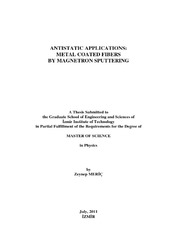Please use this identifier to cite or link to this item:
https://hdl.handle.net/11147/3155| Title: | Antistatic Applications: Metal Coated Fibers by Magnetron Sputtering | Authors: | Meriç, Zeynep | Advisors: | Özyüzer, Lütfi | Publisher: | Izmir Institute of Technology | Abstract: | The utilization of textile materials with nanotechnology is increasing in many industries especially for automobile, medical and health care. These materials have recently been of increasing interest to both the academic and the industrial sectors. Today, a wide range of nanoparticles, nanofilms and nanocomposites with various structures can be applied to the fibers, bringing new properties to the final textile product. For all these technical applications, it is desirable to produce such textile materials with especially designed surface features to meet various needs. Various techniques have been developed to functionalize textile materials. Physical vapor deposition (PVD) has been applied to modify textile materials various functions and solvent-free process. In this study, for this aim we designed a new magnetron sputtering system which is called inverted magnetron sputtering. The surfaces of synthetic fibers, such as PP and PA, whose diameters are in the range between 60-125 μm, coated with electrical conductors. In this study silver is usedbecause of silver has the highest electical conductivity in metals and additionally it has antibacterial properties. Textile fibers were coated in nanometer thickness and electrical conductivity is aimed to increase. These fibers weaved into fabrics in order to investigate antistatic and antibacterial properties. For characterization optical microscope and SEM images were taken. Besides, XRD, electrical results, mechanical strength tests were done. In order to determine optimum film thickness, by using three different methods coating thicknesses were investigated and results compared. Resistances of Ag on fibers were found and film thickness calculated from bulk Ag resistivity. The thickness was also calculated from deposited mass of silver. The both results were compared with independent thickness measurement on a glass substrate with a surface profilometer. The analysis of data commented surface scattering effect. When these fibers were weaved to become fabric due to these properties, fabrics will take place of technical textiles. Besides, the obtained fabrics have potentials to be used for electromagnetic shielding, radar absorbing materials and infrared camouflage. | Description: | Thesis (Master)--Izmir Institute of Technology, Physics, Izmir, 2011 Includes bibliographical references (leaves: 65-69) Text in English; Abstract: Turkish and English xi, 69 leaves |
URI: | http://hdl.handle.net/11147/3155 |
| Appears in Collections: | Master Degree / Yüksek Lisans Tezleri |
Files in This Item:
| File | Description | Size | Format | |
|---|---|---|---|---|
| T000968.pdf | MasterThesis | 3.59 MB | Adobe PDF |  View/Open |
CORE Recommender
Page view(s)
288
checked on Jan 13, 2025
Download(s)
126
checked on Jan 13, 2025
Google ScholarTM
Check
Items in GCRIS Repository are protected by copyright, with all rights reserved, unless otherwise indicated.